
Posts Tagged: workshop
'Trees for Tomorrow Start Today' Workshop (via Zoom) March 9, 2021 (8:15 AM - 3:00 PM)
Landscape trees provide shade, cool urban heat islands, reduce interior energy use and related costs, provide habitat for pollinators and wildlife, and beautify our communities. They also help clean our environment by absorbing carbon dioxide emitted by vehicles and other producers of fossil fuels.
Taking care of our urban trees is an important way to maximize these benefits. Unfortunately, their average lifespan in our cities is less than 1/4 of their potential due to poor selection and care. You can help enact change and increase the health, longevity and canopy coverage of our urban forests by encouraging your city leaders, local non-profit organizations interested in ‘green cities' arborists, landscape architects, nursery growers, HOAs, and concerned citizens to register for our free ‘Trees for Tomorrow Start Today' workshop (via Zoom) on Tuesday, March 9, 2021 (8:15am – 3pm).
Please reach out to your city leaders and local ‘green industry' professionals to encourage their attendance and participation. While the workshop is free, registration is required through this secure link: http://ucanr.edu/u.cfm?id=264
A bevy of speakers including certified arborists, horticulturists, planners, water district personnel and other non-profit and green industry representatives will discuss the benefits of urban trees; recommended practices for their selection and care; how to avoid hazardous trees that damage property and structures; and share success stories resulting from partnerships through cities, non-profit organizations, the green industry, HOAs, and street tree committees.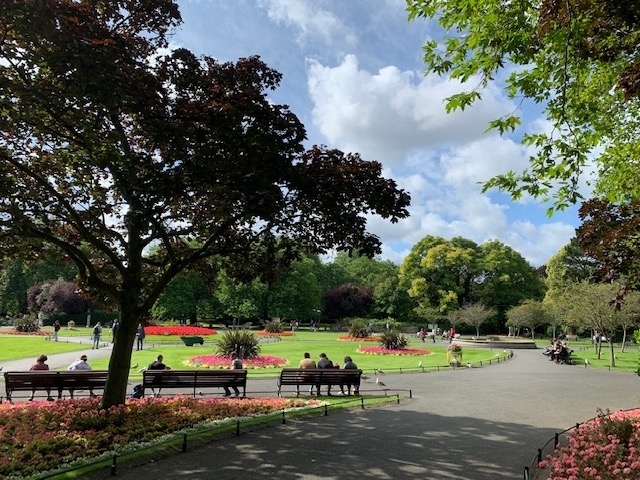
A highlight of the workshop will be the opportunity for attendees to participate in breakout sessions that cut across professions and interest groups (city planners, community service directors, arborists, landscape architects, landscapers, water district managers, HOA managers, golf course superintendents, nursery growers, UC master gardeners, concerned citizens, etc.) to enact positive change regarding tree selection and care.
Thank you for sharing this opportunity to help ensure a healthy future for our children's children with your city leaders and decision-makers.
In the meantime, here are some tree care tips to ‘start the conversation' between now and the workshop:
• Select trees that perform well in your climate. The Sunset Western Climate Zone maps are more precise than USDA zones for our warmer climates. Trees should also be selected based on their adaptation to the ‘micro-climate' in each particular landscape, as well (shade, proximity to buildings, space needs below as well as above ground, soil type, water source, etc.)
• Plant trees the same depth they were in their container in holes at least 2-1/2 times wider. Do not add compost or organic matter to the hole. This practice can result in circled roots that never grow laterally out of the confines of the dug hole.
• Remove any tree ties that are cutting into the trunk or branches of your trees. If trees must be staked due to windy conditions, make sure that the ties are loose enough to allow trees to gently flex in the wind. This helps trees develop the necessary lower trunk strength and stability to support the tree as it matures. Over time, you may be able to completely remove the ties and stakes once the lower trunk becomes stronger and self-supporting.
• Keep all plants and mulch several inches away from tree trunks.
• Keep tree trunks dry. They should not come into contact with water from sprinklers or hoses.
• Regularly water newly planted trees but water mature trees infrequently and deeply. Watering too often reduces the level of oxygen in the rootzone and can lead to waterlogged soils prone to crown and root rots. During fall, trees require only about 15% of the water they require in the summer.
• Prune trees only as needed and avoid topping them. Invest in the services of a credentialed and knowledgeable professional to correctly care for your valued trees. Find a list of International Society of Arboriculture Certified Arborists in your area here: https://www.treesaregood.org/findanarborist.
Show Me the Honey: Two UC Davis Events
Honey is the soul of a field of flowers. It's also been called "the nectar of the gods." "The bee...
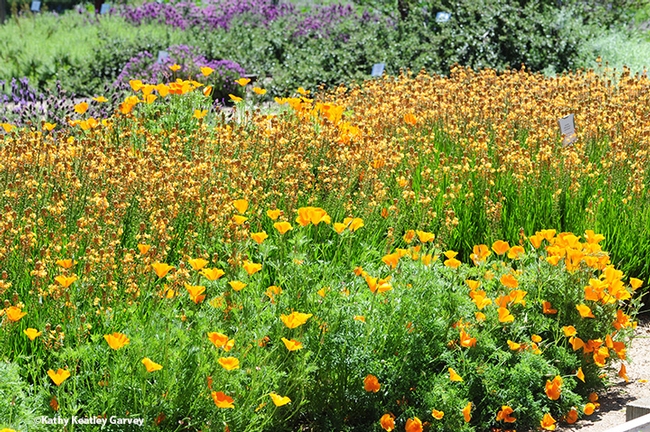
Honey is the soul of a field of flowers. This image was taken at April 2017 in a field on Bee Biology Road, University of California, Davis. (Photo by Kathy Keatley Garvey)
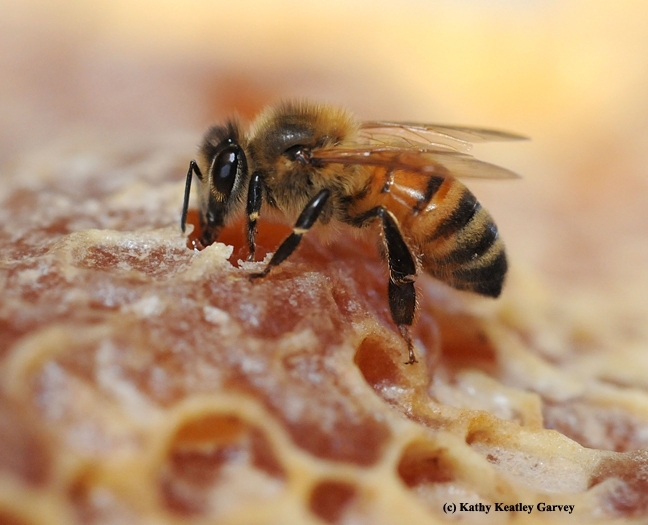
A honey bee on a honeycomb at the Harry H. Laidlaw Jr. Honey Bee Research Center, UC Davis. (Photo by Kathy Keatley Garvey)
If You're Addicted to Insect Images...
If you're addicted to insects or insect photography, you'll want to see the international...
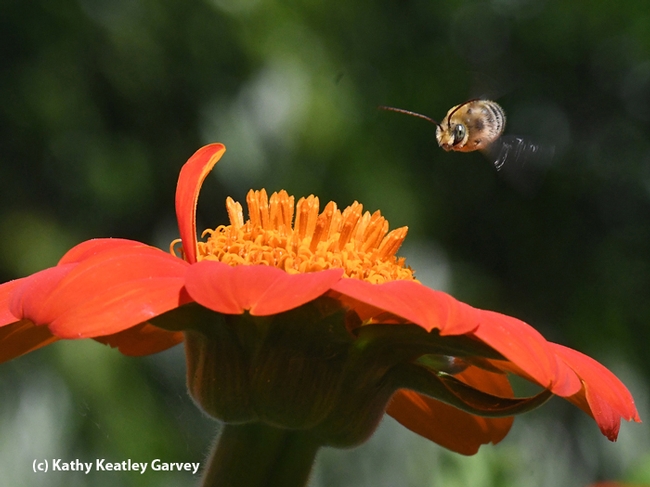
"Faster than a Speeding Bullet," shows a long-horned bee in flight, speeding over a Mexican sunflower (Tithonia rotundifolia). This one received an honorable mention in the international contest, Insect Salon. (Photo by Kathy Keatley Garvey)
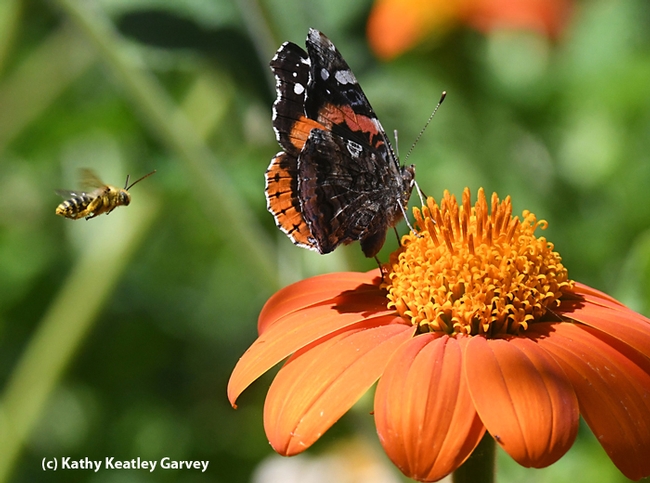
"Under Attack!" shows a long-horned bee targeting a Red Admiral butterfly (Vanessa atalanta), also on Tithonia. This image gained acceptance into the international contest, Insect Salon. (Photo by Kathy Keatley Garvey)
Why This UC Davis Course Is Sweet
"The bee hive is the ultimate home sweet home," Amina Harris, director of the UC Davis Honey and...
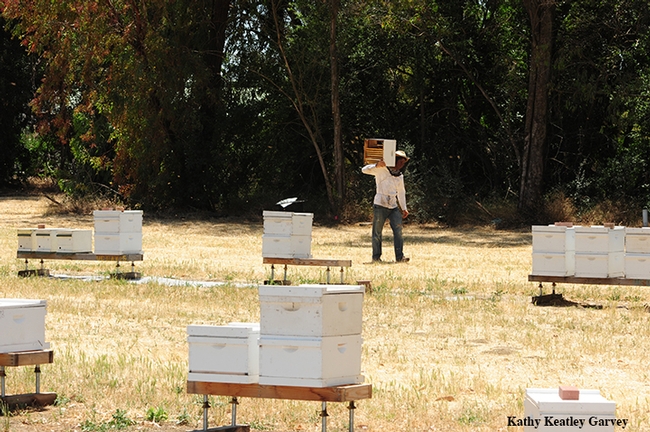
Home is where the bees are. A beekeeper at the Harry H. Laidlaw Jr. Honey Bee Facility, UC Davis. (Photo by Kathy Keatley Garvey)
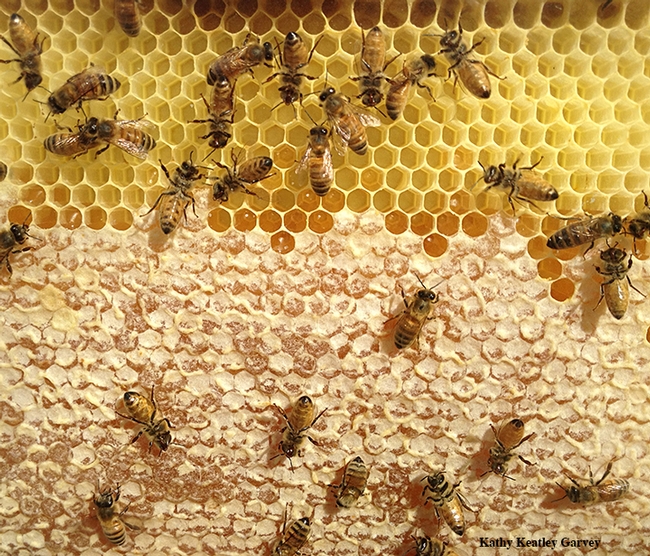
Honeycomb: "The bee hive is the ultimate home sweet home," says Amina Harris, director of the Honey and Pollination Center. (Photo by Kathy Keatley Garvey)
Mite Management and Spray Calibration Meeting
UCCE, and the Strawberry Commission with the generous sponsorship of the BASF Corporation are putting on a short preseason workshop on how to get the most out of managing mites in strawberry.
Agenda below.

Mite Workshop265
